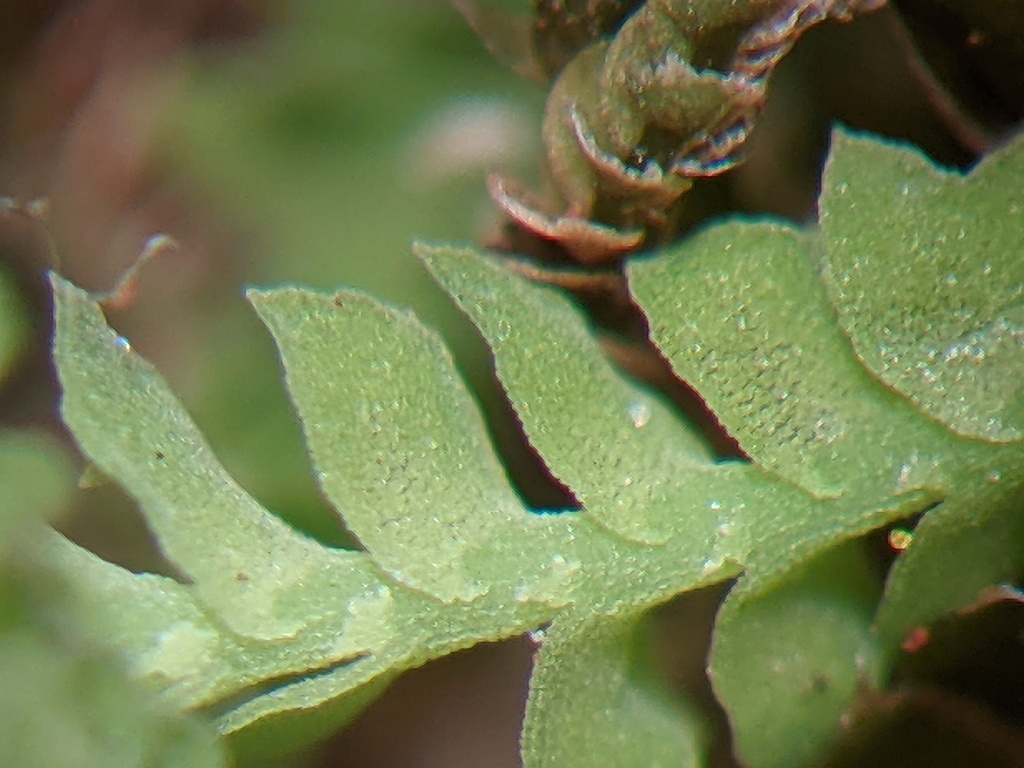Acrobolbaceae
Epiphytic, lithophytic or terrestrial, dioicous with male plants often smaller, or rarely paroicous (not in Victoria). Asexual reproduction by caducous (not in Victoria) or fragmenting leaves (not in Victoria) or by gemmae produced at apices of hairs at pit in apex of female thallus discoid, on adaxial stem near apex, or from leaf margins (not in Victoria), or by tubers produced from marsupium. Plants rarely thallose or almost always with stems with clearly differentiated and well-developed leaves. Stems with two ranks of lateral leaves and sometimes with underleaves, creeping and sparingly branched, with all branches similar or with normal leafy and microphyllous stems, or frequently branched and differentiated into creeping microphyllous stems with rhizoids and erect stems with normal leaves and without rhizoids, smooth or conspicuously papillose; branches emerging from main stem from near lateral leaves or on ventral side of stem and with a collar of tissue at base, or rarely emerging from near abaxial side of lateral leaf and without a collar of tissue at base. Leaves reniform, oblong, ovate, orbicular or obovate in outline, unlobed, bifid, or rarely with 3–5 lobes (not in Victoria), with entire to dentate or ciliate along margins, succubous, alternate or opposite, remote to imbricate, concave to convex adaxially, green, yellow green or lime green, becoming reddish or purple (not in Victoria) in well-illuminated sites, sometimes dull-textured, rarely reduced, lunate and lamellae-like; lobes when present equal or not, rounded or acute. Underleaves when present subulate, ovate, lingulate, oblong or lanceolate in outline, much narrower to wider than stem, sometimes vestigial and composed of up to 5 cells, bifid or unlobed, free or united at one or both (not in Victoria) sides with adjacent lateral leaves. Leaf cells polygonal, sometimes becoming oblong near margins, rarely becoming conspicuously more elongate toward base, especially near acroscopic margin, papillose or smooth, with or without distinct trigones, with 1–50 oil bodies; oil bodies hyaline, brown, grey or bluish (not in Victoria), ovoid, ellipsoid or fusiform, granular-botryoidal to finely granular. Rhizoids in tufts or scattered abaxially on stems, occasionally marginal on leaves, without peg-like internal thickenings, hyaline or purplish-red (not in Victoria). Androecia on main stem or on branches with or without normal leaves, with 4–30 saccate bracts, each with 1–14 antheridia. Sporophyte terminal on normal leafy stems or branches, or terminal on branches with hyaline bracts that emerge from near stem bases, surrounded by a pendent marsupium, rarely with a vestigial perianth (not in Victoria); marsupium ovoid to ellipsoid and not subterranean, or cylindric and subterranean, covered with rhizoids or glabrous. Capsule ellipsoid, cylindric or ovoid, 2–6-stratose, rostrate. Spores papillose to verrucose.
Six genera and 62 species mostly in southern South America, New Zealand and south-east Australia, but also Pantropical and in south-west Australia, South Africa, Tristan da Cunha, Macaronesia, the Azores, Ireland and the UK, North America, Japan and China (Söderström et al. 2016; Schuster 2021); five genera and ten species in Victoria. .
Schuster, R.M. (2021). Austral Hepaticae Part III. Nova Hedwigia Beiheft 120. Cramer in der Gebrüder Borntraeger Verlagsbuchbehandlung: Stuttgart.
Söderström, L., Hagborg, A., von Konrat, M., Bartholomew-Began, S., Bell, D., Briscoe, L., Brown, E., Cargill, D.C., Costa, D.P., Crandall-Stotler, B.J., Cooper, E.D., Dauphin, G., Engel, J.J., Feldberg, K., Glenny, D., Gradstein, S.R., He, X., Heinrichs, J., Hentschel, J., Ilkiu-Borges, A.L., Katagiri, T., Konstantinova, N.A., Larraín, J., Long, D.G., Nebel, M., Pócs, T., Puche, F., Reiner-Drehwald, E., Renner, M.A.M., Sass-Gyarmati, A., Schäfer-Verwimp, A., Moragues, J.S., Stotler, R.E., Sukkharak, P., Thiers, B.M., Uribe, J., Váňa, J., Villarreal, J.C., Wigginton, M., Zhang, L. & Zhu, R. (2016). World checklist of hornworts and liverworts. Phytokeys 59: 1–828.
 Spinning
Spinning